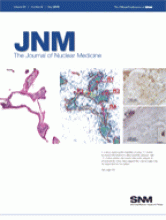TO THE EDITOR: We read with great interest a recent article by Gutte et al. (1) in which the authors compared the diagnostic accuracy of combined ventilation–perfusion (V/Q) SPECT plus low-dose CT with multidetector CT angiography. In that prospective study, a total of 81 simultaneous studies were available for analysis, with a prevalence of 38% for pulmonary embolism (PE).
Perfusion SPECT plus low-dose CT had a sensitivity of 93%, specificity of 51%, and accuracy of 68%. This low specificity is surprising and at variance with recent data using perfusion SPECT without low-dose CT, which showed high specificity and accuracy of greater than 90% (2,3). Moreover, the general impression is that the CT information would significantly increase the diagnostic accuracy, particularly the specificity. In this context, the authors had already showed that the specificity of V/Q SPECT was 88% and increased to 100% when low-dose CT was added. We wonder what the specificity would be had the perfusion SPECT been interpreted without the low-dose CT; could the specificity of perfusion SPECT be even less than 50%? Unfortunately, because the authors did not report on the diagnostic performance of perfusion SPECT, there was no comparison between perfusion SPECT with and without low-dose CT. It would be great if the authors could comment on the results of perfusion SPECT.
There is a growing impression that SPECT is more accurate than planar imaging in the diagnosis of PE (2–4). However, V/Q SPECT is underutilized because of technical issues and the high economic cost associated with the ventilation agent. Most facilities therefore will be able to perform the perfusion SPECT but not the ventilation SPECT. The perfusion SPECT can be easily performed in a single session with the planar V/Q scan and is not associated with additional radiation exposure. However, interpretation criteria for perfusion SPECT are not yet clearly defined. Gutte et al. (1) did mention that “PE was diagnosed if one or more mismatched perfusion defects with normal ventilation were present,” but it was not clear to the readers whether only large subsegmental perfusion defects and larger defects were categorized as suggestive of PE or whether small and moderate subsegmental perfusion defects were considered suggestive as well. We would appreciate a statement from the authors on this matter.
The discrepancy between the relatively low accuracy of perfusion SPECT plus low-dose CT and the high accuracy of V/Q SPECT plus CT in the study is considerable. It would be important to reanalyze the data to define the scintigraphic pattern responsible for the low specificity, 51%, when perfusion SPECT plus CT was used instead of V/Q SPECT plus CT. The information gained from this reanalysis would help us better understand the strengths and pitfalls of perfusion SPECT and help improve diagnostic confidence and accuracy.
Footnotes
-
COPYRIGHT © 2010 by the Society of Nuclear Medicine, Inc.







